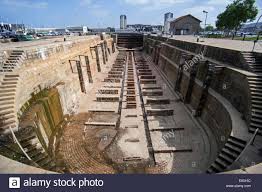
Docking is the terms used for repairs, maintenance, or construction where the vessel is brought to the dry area to perform the maintenance activity. There several docking types that we need to know which divided based on the process of bringing the vessel to the dry land. Drydocking also has the similar meaning with docking which refers to the vessel that is brought to the dry land. Drydocking is usually done every 12 or 24 months as the rule to ensure that the vessel is still in good condition and do the necessary maintenance and repair. Docking activity covers replacing parts, painting, cleaning, surveying, and many others. After the docking process is finished, the vessel will get a docking report as the renewal document of seaworthiness of the vessel and permitted to get back to work.
The dry dock itself is a narrow basin or a vessel that can be flooded and drained to allow the vessel to be loaded in it and do the maintenance or repair in the dry land. There are two types of dry dock as explained below:
Graving Dock
Graving dock is a classic form of the dock. Usually, it is made from concrete and closed by gates or a caisson. Graving dock is the narrow basin that allows a vessel to go inside and afterward the water will be pumped out leaving the vessel supported on the prepared blocks. The blocks are prepared on the floor of the dock in accordance with the docking plan of the vessel. While the dock is flooded the divers will ensure that the prepared block is still in its places and ready to support the vessel when the water is pumped out. After all the water is pumped out, the inspection, maintenance, and repair process can be started. Having the water pumped out makes the inspection feasible to be done especially for the bottom area and start to do the repair activity such as removal of barnacles and rust, repainting, and many others. Usually, graving dock size is bigger than a floating dock.
Floating Dock
The second types of the dock is a floating dock. This docking type is the modern docking types which allow the dock to be moved. Floating dock is similar to a pontoon or a barge which has floodable buoyancy chambers and a U-shape cross-section. This feature allows the floor of the floating dock to go below the surface water when loading the vessel. On the other hand, when the vessel is loaded, the water in the "chamber" will be pumped out and the floor of the floating dock will be able to float above the surface of the water. Since the floating dock is just like a pontoon, it is located on the sea, and it can be moved using a tugboat. Furthermore, since it is located in the sea, a floating dock will also need an annual maintenance or even a repair just like a vessel. However, the maintenance and repair will not as much as a vessel.
Both of the docking types have the same function which is to bring the vessel into the dry land. Each of the docking types also has its own plus and minus points. Feel free to learn more about the docking types from other articles.
Dredgers are important machines used for excavation and land reclamation in water bodies. They come in different shapes, sizes, and types, depending on the specific purpose they are designed for. I....
Pilot boats play a vital role in ensuring the safety and efficiency of maritime transportation. These boats are designed to transport pilots to and from ships that require their expertise in navig....
Self-propelled barges are vessels that are designed to transport large quantities of cargo on inland waterways. These barges are propelled by their own engines, making them highly efficient and cos....
Barge/ Dumb Barge A barge is a flat-bottomed boat that is designed to transport goods or people on inland waterways or near-shore locations. Dumb barges, also known as unpowered barges, are t....